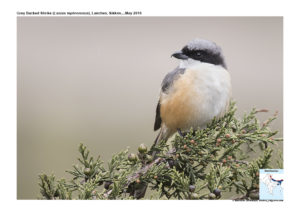Grey-backed Shrike

Grey-backed shrike Lanius tephronotus
Etymology :
- Lanius : Latin word for Butcher . They are known as ‘butcher-birds,’ from their habit of storing prey by impaling it on thorns and sharp twigs, giving the resemblance to a butcher’s slaughterhouse
- Tephronotus : Greek word tephros ash-coloured ; notos -backed
Vernacular Names : Lepcha: Sakrik pho, Nepal: Bhadraya, Bagaha tentha, Bhutan: Totem, Tibetan: Tre tre
Distribution in India: Breeds in Himalayas. Winter visitor in Himalayas, North and North east of India.
Description: Size of 23-25 cm. Nominate race has black lowermost forehead just over base of bill and facial mask through lores and eye to rear ear-coverts; crown to nape and most of upperparts dark grey, small rufous rump patch; upperwing black, most wing-coverts, secondaries and tertials fringed pale rufous to whitish, sometimes tiny white patch at base of primaries (often lacking); tail chestnut-brown, tipped buffish, outermost pair of retrices light brown; throat and underparts white, breast side and flanks rufous, undertail brownish-grey; iris dark brown; bill black; legs dull black. Sexes very similar.
Habit : It is found during breeding period at high elevations in forest clearings, plateau plains and mountain meadows dotted with small trees or fairly large bushes; to at least 4500 m. During non-breeding it is found in valleys and plains found in variety of habitats, including gardens and abandoned cultivation.
Food Habits: It eats mostly insects, such as crickets and grasshoppers,beetles and caterpillars; small vertebrates, such as lizards, frogs, birds and small rodents, may also be consumed. Hunts from open perch, taking prey mostly on ground; some insects hawked in air. Impales prey; keeps larder.
Breeding Habits: They breed in Jun- July. Nest a bulky, rather untidy-looking cup, made mainly from twigs and grass, in small tree or bush, either isolated or in stream side thicket or row of trees. They lay a clutch of 4–6 eggs. The incubation period is 15–18 days, by females only; fledging period 14–15 days; both parents feed the nestlings